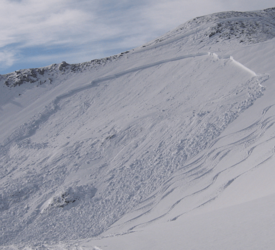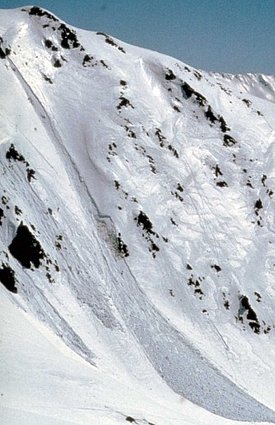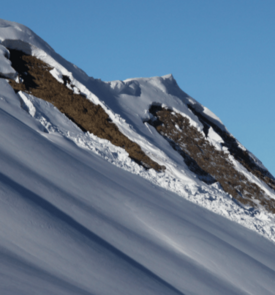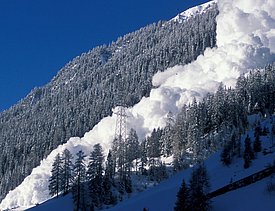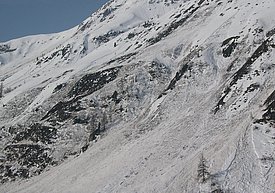
Avalanche types ¶
Avalanches are not identical, but can be assigned to several distinct categories. Slab avalanches are especially dangerous for winter sport participants.
Slab avalanches ¶
Slab avalanches have a distinct, broad fracture line. They can occur only when a bonded layer of snow (the slab) is lying on top of a weak layer over a sufficiently large area. Triggering requires the application of an additional load and a slope angle of at least 30°. The avalanche is released by a small fracture that initially occurs in the weak layer (initial failure) and then rapidly propagates across it. The extent to which the fracture propagates depends on the properties of the weak layer and on the slab that is lying on top. Once released, the slab slides down the slope. The typical size of a slab avalanche released by winter sport participants is 50 metres wide and 150 to 200 metres long.
Slab avalanches can occur in dry or wet snow, even a long time after any snowfall. They can release naturally (without human assistance) or be triggered at any point within or even outside (in case of remote triggering) the perimeter of the slab. Slab avalanches are the most dangerous type and responsible for more than 90% of the deaths that occur in avalanches.
Slab avalanches can be dangerous even if they are not large. They reach a high speed quickly. A person who releases a slab is often within its perimeter and caught in the avalanche.
Loose snow avalanches ¶
Loose snow avalanches fan out from a point of triggering as they plummet downhill and sweep along more and more snow. This type of avalanche often occurs during or shortly after snowfall, or when significant warming occurs. A loose snow avalanche consisting of dry powder generally requires a slope angle of 40°. Especially when the snow is wet, these avalanches can reach considerable size in continuously steep terrain.
Loose snow avalanches are often released naturally. Less than 10% of avalanche fatalities are attributable to them. Many of the deaths occur in summertime, when mountaineers in steep terrain are swept along and then fall. A snow sport participant who triggers a loose snow avalanche is seldom buried because it slides down the slope away from him and usually releases only small snow masses.
Gliding avalanches ¶
Like slab avalanches, gliding avalanches have a distinct, broad fracture line, but they differ inasmuch as the entire snowpack is released. They can occur only on a smooth substrata, typically consisting of flattened grass or slabs of rock. The steeper the slope, the more likely the snow is to slide.
Gliding avalanches can be a major problem for transport routes, especially in snowy winters. They are of only secondary significance for winter sport enthusiasts because they cannot be triggered by people. These avalanches are released naturally when friction decreases at the interface with the ground as the snow at the base of the snowpack becomes moist. Water can penetrate the lowermost layer in two different ways:
- In mid-winter the snowpack is usually cold and dry. During this period it becomes moist from underneath, either as the warm ground melts the snow above, or as the snow absorbs water from the moist ground. Gliding avalanches can occur at any time of day or night in mid-winter.
- At some time in the spring, the snowpack reaches a temperature of zero degrees (isothermal) throughout. This allows melt water and rain to seep through the entire snowpack and moisten its base from above. In these conditions gliding avalanches often occur in typical wet snow avalanche periods, and their frequency increases in the second half of the day.
Often, but by no means in every case, the snowpack begins to slide slowly where gaps (glide cracks) have formed within it. These signs can suddenly be followed by a gliding avalanche. It is impossible to predict exactly when this will happen, so that people should avoid lingering below or alongside glide cracks for any longer than absolutely necessary.
Powder avalanches ¶
Powder avalanches arise mostly from slab avalanches. A powder cloud forms in the presence of a large altitude difference when a sufficient quantity of snow becomes suspended in the air. Powder avalanches can reach a speed of 300 km/h and cause tremendous damage. They occur most commonly when the avalanche danger is high or very high.
Wet snow avalanches ¶
Wet snow avalanches can consist of a slab or loose snow. They frequently release naturally, especially in the event of rain or after daytime warming, and occur in springtime in particular. The main cause of wet snow avalanches is the presence of liquid water in the snowpack, which significantly weakens bonding at layer boundaries. Water accumulates and gives rise to instability in particular where large differences in grain size exist between contiguous layers. Regions where the bonding of the snowpack is poor are especially prone to wet snow avalanches.
Our interactive prevention platform White Risk is a source of extensive knowledge on avalanche types.
